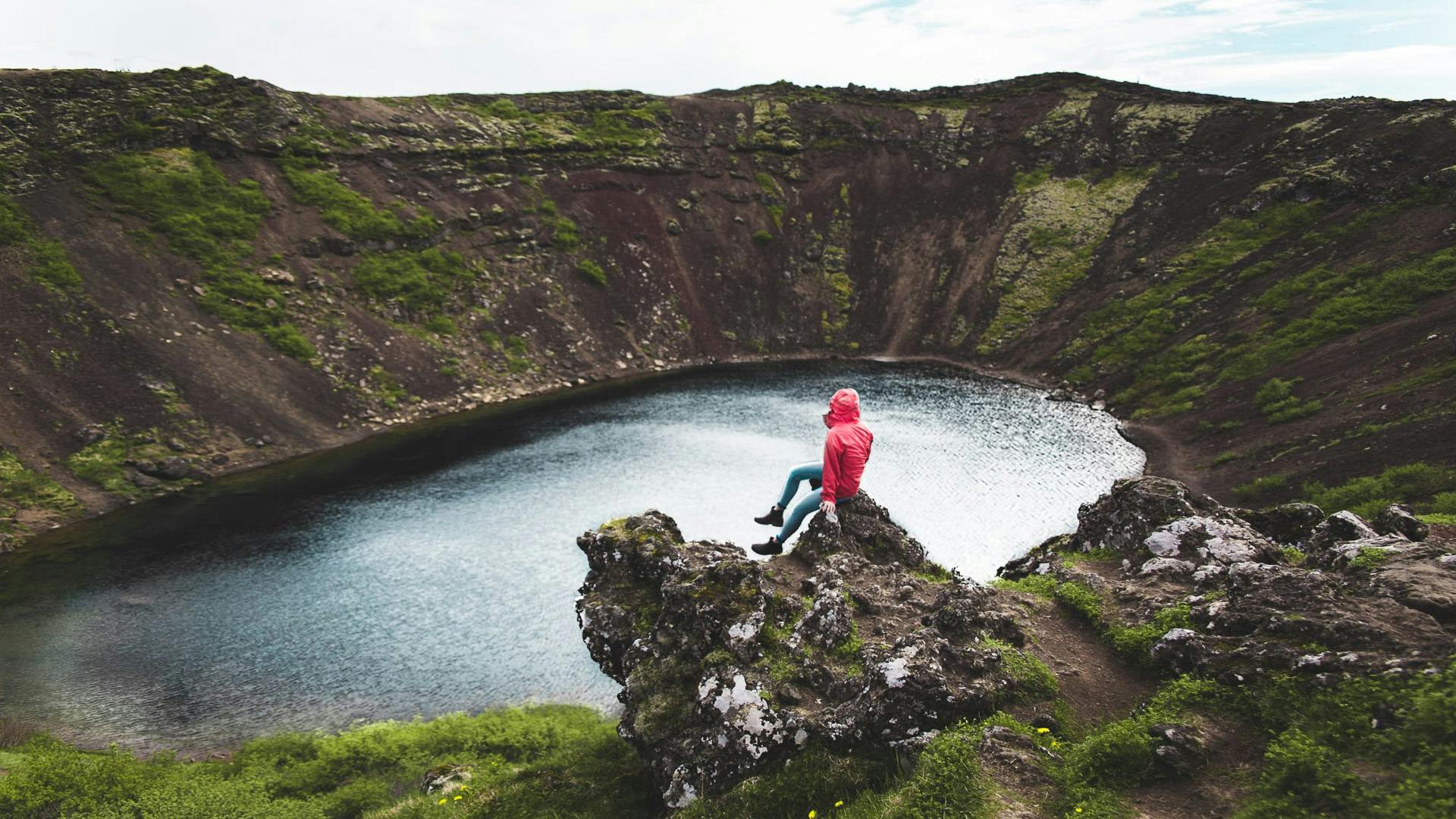
Kerid – The Most Famous Volcanic Crater in Iceland
Kerid is a volcanic crater in south of Iceland, located perfectly to add to the world famous Golden Circle route of Iceland. This is your chance to see a unique geological phenomenon with your own eyes during a day trip from Reykjavík. In the summer or winter months Kerið is beautiful. The rock formations there and the easy hiking trail to the top is an adventure you must enjoy.
Imagine yourself standing above a volcanic crater with unique red volcanic rocks going down the slope measuring 270 meters in circumference, 170 meters wide and 55 meters deep? Yes, you guessed it right! The magical site is none other than the Kerid crater in Iceland. The 3,000-year-old volcanic crater in South Iceland is undoubtedly the perfect Golden Circle detour. With most of its caldera still intact, this shallow lake has an easy hike around the rim of the crater to enable visitors to get a closer view. We at Tröll understand that when going to Iceland, expeditions can vary. When taking the Kerid Crater Hike your experience is beyond this world. The opaque aquamarine shade of blue water is a result of the minerals from the surrounding soil. Apart from the walls of red volcanic rocks, the lake is surrounded by vibrant green moss. If you time your visit right, you may get to witness the spectacular Northern Lights in the late evenings!
Location and Geological Factors
Located in South Iceland 15 kilometers north of Selfoss, the Kerid crater was the result of an eruption over 3,000 years ago. On the main road that connects the Golden Circle to Selfoss, Kerid is worth stopping at and witnessing nature’s bounties. Kerid is a 40-minute drive from Þingvellir National Park and also a part of a group of volcanic hills called Tjarnarhólar. It also forms a part of the Western Volcanic Zone in Iceland, which includes the Langjokull glacier and the Peninsula of Reykjanes.With the visually recognizablecalderas, the milky blue-green water amid the glaring black and deep red slopes make for a breathtaking view for the visitors.
Origin of Kerid
While the exact origin of Kerid has been a subject of debate among scientists, the crater is believed to have been formed 6,500 years ago due to an explosive eruption. It is, therefore, known as an ‘explosion crater’. However, most scientists today are of the view that Kerid was a cone-shaped volcano, which erupted and exhausted its magma reservoir. The eruption made the foundation of the volcano fall on itself and resulted in the formation of the crater as we see it today. A hundred years following the collapse of the volcano, the crater was filled with water. Beneath the still water at the bottom, cavities and fissures in the rocks are filled with groundwater. The pool of water is of the same level as the water table. Depending upon the amount of rainfall and season, the depth of the water remains between seven to 14 meters. Since the crater is surrounded with rocks in a circular fashion, the water inside does not drain out. The water remains inside with the rise and fall of the level in the water table.
How to get there
While the water turns icy and the surroundings of the lake turn white with snow in winter, the red volcanic walls and the aqua blue water welcome visitors during the summers, as a perfect addition to your day tours. The best time to visit Kerid is during summers when the fauna in and around the crater, the natural colors of the rock and the aquamarine color of the water make the attraction worth the visit. During intense winters, the water in the crater freezes and the route to descend inside the crater becomes slippery and dangerous because of possible ice formations. We don’t want your trip to Kerid to turn in to a glacier walk. Although Kerid crater is open for public view, the land around the crater is private and the owners charge an amount of USD 4 for the maintenance of the area.
Most tourists visit Kerid as a part of the Golden Circle tour. The best tour of Iceland is never complete without visiting the Golden Circle, Gullfoss Waterfall, Geysir Hot Springs, The Secret Lagoon and Reykholt, among other places.
If you want to hop on a small group expedition that includes the Golden circle, Kerid and a fun farm visit, you should check this tour out. Most tourists spend an average of an hour at Kerid, walking on the edge of the crater and clicking photographs. Being a photographer’s paradise, Iceland is dotted with astounding landscapes. The last few years have witnessed a surge in the number of photography tours and workshops. If you are thinking about starting your Iceland expedition in Reykjavík and working your way all the way to Skaftafell national park , there are many places on the way there worth visiting, you could stop by Sólheimajökull glacier, Reynisfjara beach and see the amazing basalt columns, watch out for sneaker waves, Katla volcano, dragon ice cave, check out this expedition here. When you reach Skaftafell you can join us in a expedition to the Skaftafell blue ice cave and discover the amazing features of the glacier here.
Dying for a vacation in Iceland, aren’t you? Guess some of you must have got your travel diaries out to list down your things to do in Iceland. Be it amateurs or professionals, photographers continue to visit the country throughout the year. But in this land of deep valleys, highlands, black beaches, active volcanoes and crystal ice caves a lot of places remain unexplored by humans and pristine in their own right. Having whetted your appetite for expedition, we sign off on a note of curiosity. So when are you traveling to Iceland?